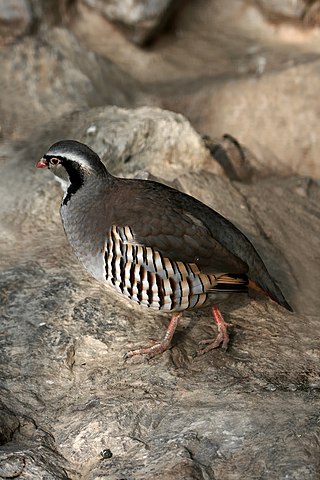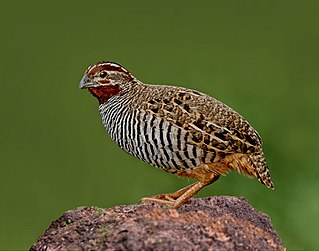
A partridge is a medium-sized galliform bird in any of several genera, with a wide native distribution throughout parts of Europe, Asia and Africa. Several species have been introduced to the Americas. They are sometimes grouped in the Perdicinae subfamily of the Phasianidae. However, molecular research suggests that partridges are not a distinct taxon within the family Phasianidae, but that some species are closer to the pheasants, while others are closer to the junglefowl.

The black francolin is a gamebird in the pheasant family Phasianidae of the order Galliformes. It was formerly known as the black partridge. It is the state bird of Haryana state, India. Fried black francolin is eaten in Azerbaijani cuisine.

The chukar partridge, or simply chukar, is a Palearctic upland gamebird in the pheasant family Phasianidae. It has been considered to form a superspecies complex along with the rock partridge, Philby's partridge and Przevalski's partridge and treated in the past as conspecific particularly with the first. This partridge has well-marked black and white bars on the flanks and a black band running from the forehead across the eye down the head to form a necklace that encloses a white throat. Native to Asia, the species has been introduced into many other places and feral populations have established themselves in parts of North America and New Zealand. This bird can be found in parts of Middle East and temperate Asia.

The rock partridge or common rock partridge is a gamebird in the pheasant family, Phasianidae, of the order Galliformes. It is native to southern Europe, and is closely related and very similar to its eastern equivalent, the chukar partridge, A. chukar.

The Barbary partridge is a gamebird in the pheasant family (Phasianidae) of the order Galliformes. It is native to North Africa.

Alectoris is a genus of partridges in the family Phasianidae, closely related to Old World quail, snowcocks (Tetraogallus), partridge-francolins (Pternistis), bush quail (Perdicula), and sand and see-see partridges (Ammoperdix). Members of the genus are known collectively as rock partridges. The genus name is derived from the Ancient Greek: αλέκτωρ, romanized: alektoris, meaning "chicken" or "farmyard fowl".

The Daurian partridge, also known as steppe partridge, Asian grey partridge or bearded partridge, is a gamebird in the pheasant family Phasianidae of the order Galliformes. Its name derives from the Dauria region of Russia, which forms part of their distribution.

The Tibetan partridge is a gamebird in the pheasant family Phasianidae of the order Galliformes. They are found widely across the Tibetan Plateau and have some variations in plumage across populations. They forage on the ground in the sparsely vegetated high altitude regions, moving in pairs during the summer and in larger groups during the non-breeding season. Neither males nor females have spurs on their legs.

The stone partridge is a bird of the New World quail family. This largely brown bird, which commonly holds its tail raised, is found in scrubland and lightly wooded habitats, often near rocks, from Kenya and Ethiopia to Gambia.

The jungle bush quail is a species of quail in the family Phasianidae. It is native to the Indian subcontinent, where it is found in peninsular India and Sri Lanka. It has also been reported from Nepal but has not been seen there since the 19th century, and an introduced population exists on the island of Réunion. A small species of quail 15–18 cm (5.9–7.1 in) long and weighing 57–82 g (2.0–2.9 oz), it shows significant sexual dimorphism. Males have brown upperparts with blackish and buff marking and whitish underparts with black barring. The face is mainly dark reddish-brown, with brown ear-coverts, a buffy-white moustachial stripe, and the supercilium turning whitish towards the back of the neck. Females have a similar pattern, but with pinkish-brown underparts, more uniform wings, and duller moustachial stripes.

The yellow-legged buttonquail is a buttonquail, one of a small family of birds which resemble, but are unrelated to, the true quails. This family is peculiar in that the females are larger and more colourful than the males and are polyandrous.

Philby's partridge or Philby's rock partridge, is a relative of the chukar, red-legged partridge and barbary partridges and is native to southwestern Saudi Arabia and northern Yemen. Although similar in appearance to other Alectoris species, Philby's partridge can be distinguished by its black cheeks and throat. Although not currently listed as an endangered species, the Arab Spring and destruction of its fragile habitat in the tribal areas of Northern Yemen had led to concerns about the survival of this species. The name commemorates the British explorer St John Philby.

The blue quail or African blue quail is a species of bird in the family Phasianidae found in sub-Saharan Africa.

Perdicinae is a polyphyletic former subfamily of birds in the pheasant family, Phasianidae, regrouping the partridges, Old World quails, and francolins. Although this subfamily was considered monophyletic and separated from the pheasants, tragopans, junglefowls, and peafowls (Phasianinae) till the early 1990s, molecular phylogenies have shown that these two subfamilies actually constitute only one lineage. For example, some partridges are more closely affiliated to pheasants, whereas Old World quails and partridges from the Alectoris genus are closer to junglefowls. Due to this, the subfamily Perdicinae is no longer recognized by the International Ornithological Congress, with the species being split among 3 subfamilies.


















